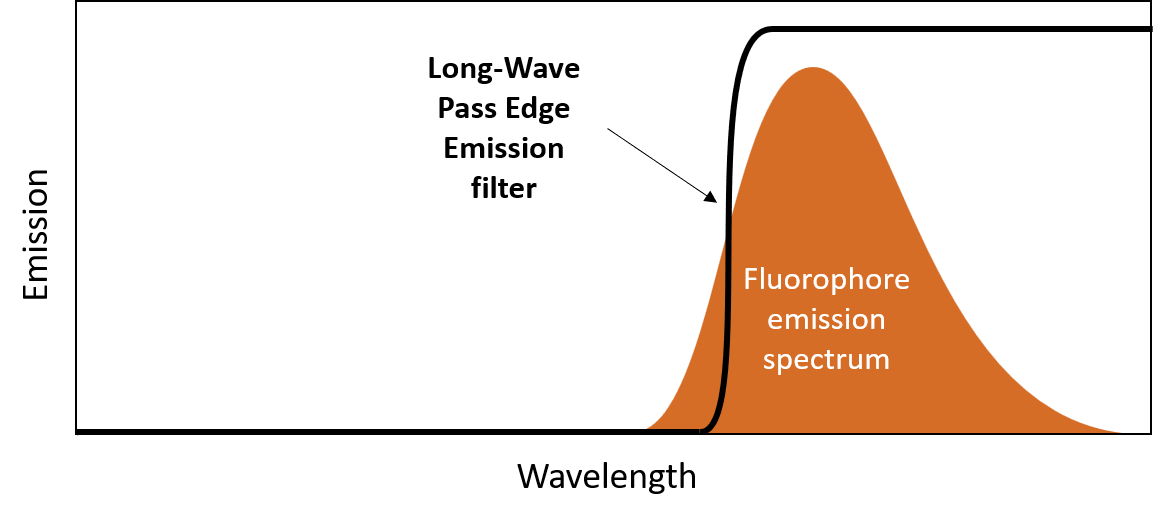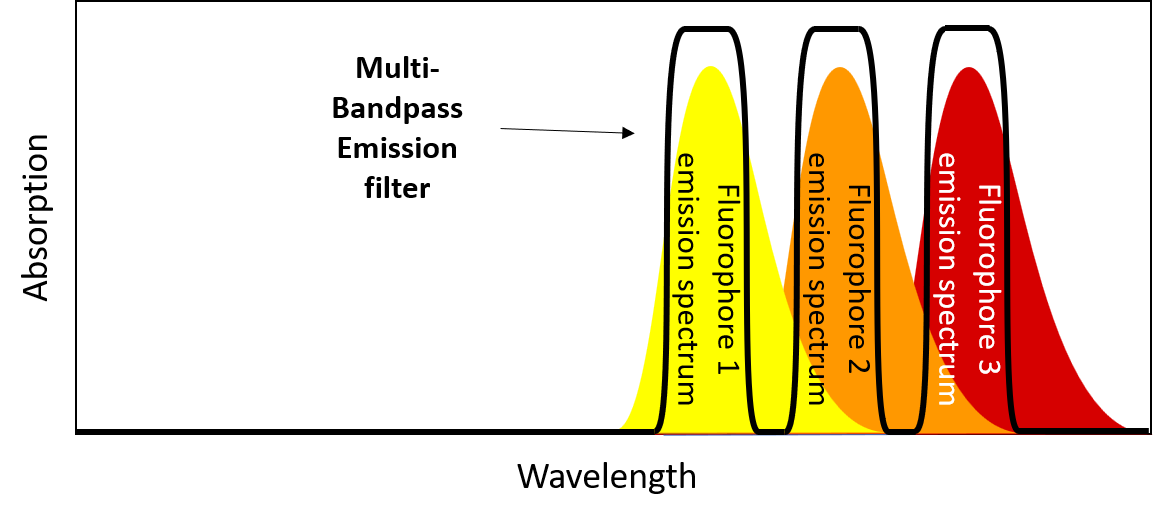Explore the many types of optical filters used in fluorescence microscopy.
Fluorescence filters
Fluorescence filters are essential components in fluorescence microscopes, spectrophotometers, microplate readers, and flow cytometers. A wide variety of filter types are available, making it challenging to choose the most suitable filters for a specific application.
Overall, the choice of filters for your fluorescence instrument will be determined by the absorption and emission peaks of the fluorophore you are using. However, even when the fluorophore(s) are known, there are still many fundamentally different options for filter types to choose from. On this page, you will find a brief description of the most common types of filters used in fluorescence-based instruments.
Key functions performed by fluorescence filters
Fluorescence filters can be grouped into three basic categories based on their function:
- Excitation filters
- Dichroics
- Emission filters
The filters are commonly used in a configuration as shown in the figure. The excitation filter selects the appropriate wavelength from the light source to excite the fluorophore in the sample. The dichroic mirror guides the excitation light to the sample and directs the emitted fluorescence to the detector. Lastly, the emission filter selects the emission peak wavelength from the fluorophore in the sample while blocking the excitation light.
Excitation filters
An excitation filter is an optical filter used in fluorescence microscopy and other fluorescence spectroscopy based techniques to select the wavelength of light that is used to excite a fluorophore.
Other terms used for an excitation filter are primary filter or exciter filter.
The excitation filter ensures that only the appropriate wavelengths of light are used to excite the fluorophores, which helps in obtaining high-quality and specific fluorescence signals from the sample.
An excitation filter can be implemented as four fundemantally different types of filters as described in the following.

Excitation Edge filters
Since the excitation wavelength is always shorter than the emission wavelength for fluorophores, a Short-Wave Pass Edge filter can be used as an excitation filter.
The edge filter transmits wavelengths shorter than the edge wavelength and blocks wavelengths longer than the edge wavelength.
The steeper the edge of the filter, the better it separates excitation from emission.

Excitation Bandpass filters
The most common type of excitation filter is a Bandpass filter with center wavelength matching the peak absoprtion wavelength of the fluorophore used.
Compared with the edge filter, the bandpass filter blocks wavelengths outside the absorption band of the fluorophore. This reduces the amount of unwanted back-ground light and thereby improves contrast.

Excitation Multi-Bandpass filters
More advanced fluoresence applications might utilize mulitple fluorophores simultaneously in so-called mutiplexed fluorescence. In this case, the light source can be an array of Light Emitting Diodes, each selected with a peak wavelength mathing one of the fluorophore absorption peaks.
With the use of a a Multi-Bandpass filter as excitation filter, it is possible to build a compact, simple and ruggedized fluorescence instrument supporting multiplexed fluorescence applications.

Tunable excitation filters
The most versatile type of instruments enable the user to tune the excitation wavelength to match any fluorophore. This is commonly implemented with rotating grating monochromators. However, the same functionality can be efficiently implemented using a set of slidable Continously Variable filters.
By combining one of our Continuously Variable Short-Wave Pass Filters (CVSWP) with a Continuously Variable Long-Wave Pass Filter (CVLWP), a tunable Bandpass Filter can be implemented where both center wavelength and bandwidth are tunable. Watch a video to see how this works.

Dichroics
As mentioned earlier, some fluorometer set-ups use a dichroic beamsplitter to separate the excitation from the emission light. A dichroic filter is a special kind of LWP edge filter that is optimized for 45 degrees Angle of Incidence (AOI).
The dichroic filter is using the fundamental property of a dielectric filter that wavelengths that are not transmitted are reflected.
Since the fluorescent emission is much weaker in intensity than the excitation light it is important that the transmission of the LWP filter is as high as possible. Dichroic filters can typically offer more than 90% transmission. The blocking of the transmitted excitation light is typically 2 – 3 orders of magnitude (OD2-OD3).
For advanced fluorescence set-ups where the excitation and emission bands need to be changed, it can be necessary that the edge wavelength of the dichoic is tunable. This can be obtained using Continuosly Variable Beamsplitter.

Emission filters
An emission filter is an optical filter used in fluorescence microscopy and other fluorescence spectroscopy based techniques to select the wavelength of light that is emitted from a fluorophore.
Other terms used for an emission filter are secondary filter or barrier filter.
The emission filter ensures that only the appropriate wavelengths of light emitted from the fluorophore is hitting the detector, which helps in obtaining high-quality and specific fluorescence signals from the sample.
An emission filter can be implemented as four fundemantally different types of filters as described in the following.
Emission Edge filters
Since the emission wavelength is always longer than the excitation wavelength for fluorophores, a Long-Wave Pass edge filter can be used as an emission filter.
The edge filter transmits wavelengths longer than the edge wavelength and blocks wavelengths shorter than the edge wavelength.
The steeper the edge of the filter, the better it separates excitation from emission.

Emission Bandpass filters
The most common type of emnission filter is a Bandpass filter with center wavelength matching the peak fluorescence wavelength of the fluorophore used.
Compared with the edge filter, the bandpass filter blocks wavelengths outside the absorption band of the fluorophore. This reduces the amount of unwanted back-ground light and thereby improves contrast.

Emission Multi-Bandpass filters
More advanced fluoresence applications might utilize mulitple fluorophores simultaneously in so-called mutiplexed fluorescence. In this case, the fluorophores are chosen such that they emit at different wavelengths to enable differentiation between various molecular groups..
With the use of a Multi-Bandpass filter as emission filter, it is possible to build a compact, simple and ruggedized fluorescence instrument supporting multiplexed fluorescence applications.

Tunable emission filters
The most versatile type of instruments enable the user to tune the emission wavelength to match any fluorophore. This is commonly implemented with rotating grating monochromators. However, the same functionality can be efficiently implemented using a set of slidable Continously Variable filters.
By combining one of our Continuously Variable Short-Wave Pass Filters (CVSWP) with a Continuously Variable Long-Wave Pass Filter (CVLWP), a tunable Bandpass Filter can be implemented where both center wavelength and bandwidth are tunable. Watch a video to see how this works.

GFP and DAPI excitation and emission filters
Some of the most widely used fluorophores are Green Fluorescent Protein (GFP) and 4′,6-diamidino-2-phenylindole (DAPI).
A set of fluorescence filters might therefore be referred to as GFP excitation and emission filters or DAPI excitation and emission filters. This often refers to a set of two bandpass filters and a dichroic mirror optimized for the absorption and emission peaks of GFP and DAPI, respectively.
In many experiments, however, it is common to modify the fluorophore to enable it to bind to a specific target molecular group. This modification might change the absorption and emission spectra of the fluorophore, so it is always advisable to check these spectra before ordering a filter set.
Stay updated on our expert insights
Get the latest news and insights about optical filters – subscribe to our newsletter.